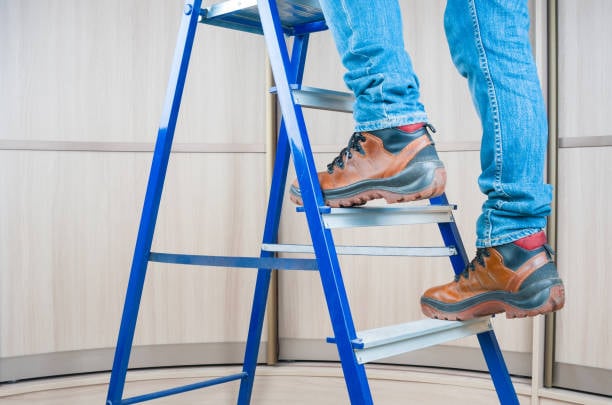
1. Choose the Right Ladder for the Job
Different tasks require different ladders. Consider the following when selecting a ladder:
- Step Ladders – Ideal for indoor use and low-height tasks.
- Extension Ladders – Best for reaching high places like roofs and gutters.
- Articulating (folding) Ladders – Versatile for various tasks.
- Fiberglass vs. Aluminum – Fiberglass ladders are non-conductive, making them safer for work near electrical lines.
2. Inspect the Ladder Before Use
Before using a ladder, inspect it for damage such as cracks, loose rungs, or bent rails. Never use a damaged or unstable ladder, as it increases the risk of falling.
3. Set Up on a Stable Surface
Always place your ladder on a level, firm surface. Avoid soft ground or uneven areas. If necessary, use ladder levelers or stabilizers to ensure stability. When using an extension ladder, position it at a 4-to-1 ratio (for every 4 feet of height, the base should be 1 foot away from the wall).
4. Maintain Three Points of Contact
To prevent falls, always maintain three points of contact—two hands and one foot or two feet and one hand—while climbing. This helps ensure balance and stability.
5. Don't Overreach
Overreaching can cause the ladder to tip over. Keep your body centered and move the ladder as needed instead of stretching too far to the side.
6. Wear Proper Footwear
Slip-resistant shoes with good traction can help prevent slipping. Avoid sandals, flip-flops, or shoes with smooth soles when climbing a ladder.
7. Use a Tool Belt or Hoist
Carrying tools in your hands while climbing can make balancing difficult. Use a tool belt or a rope-and-bucket system to lift tools and materials safely.
8. Follow Weight Limits
Check the ladder’s weight rating and ensure it can support your weight along with any tools or equipment. Never exceed the maximum load capacity.
9. Be Aware of Power Lines
If working outdoors, always look for overhead power lines. Keep ladders at least 10 feet away from electrical lines to avoid the risk of electrocution.
10. Never Use a Ladder in Bad Weather
Rain, wind, and snow can make ladders slippery and unsafe. If conditions are poor, postpone your work until it’s safe to proceed.
By following these ladder safety tips, you can reduce the risk of accidents and injuries while working at heights. If your home maintenance tasks involve difficult-to-reach areas, consider hiring a professional to handle the job safely. Stay safe, take precautions, and use your ladder wisely!
